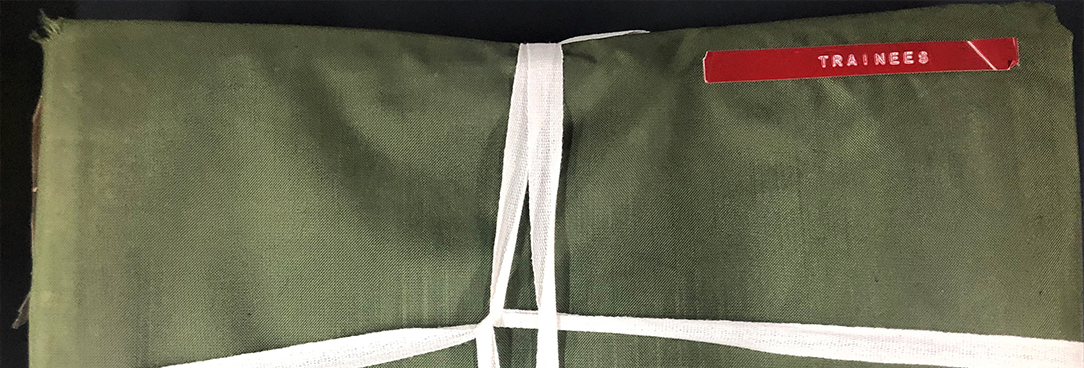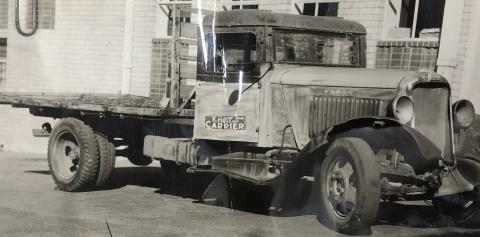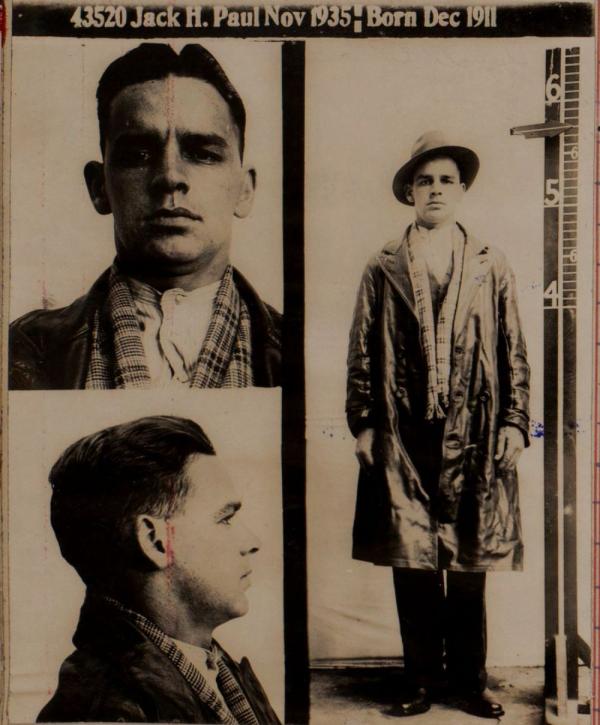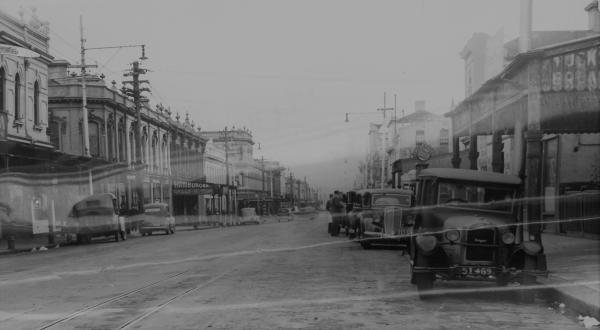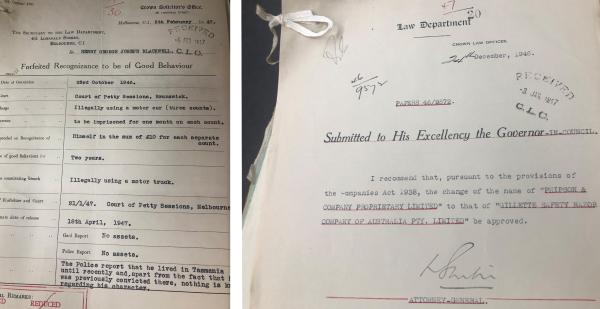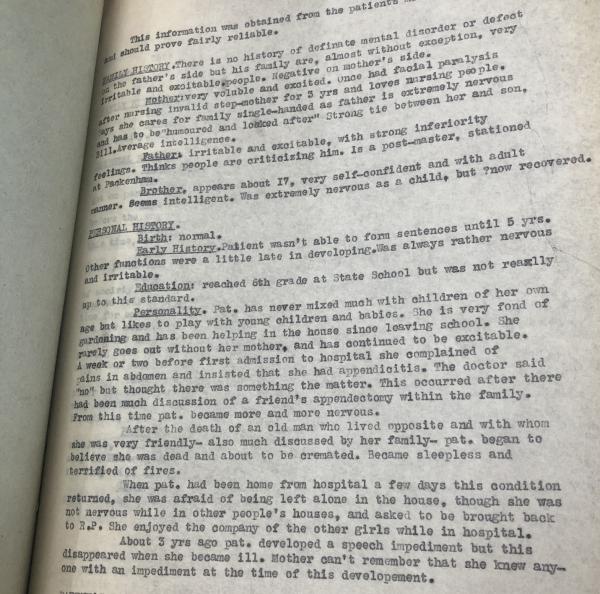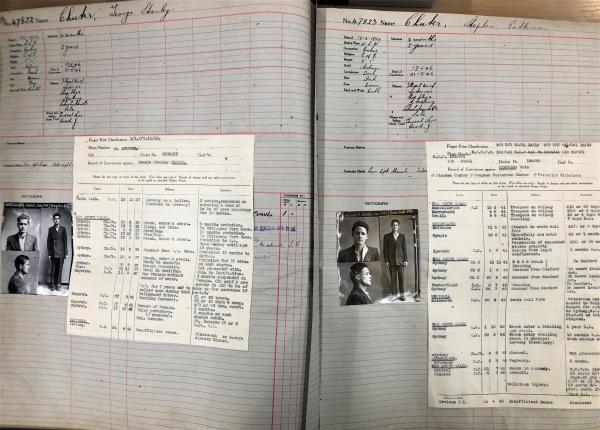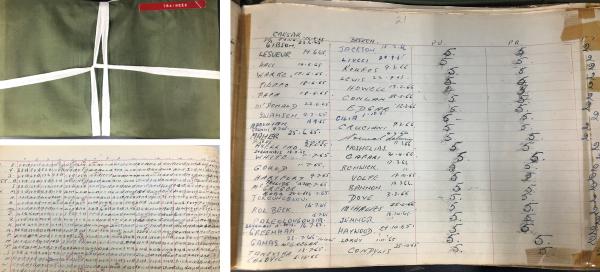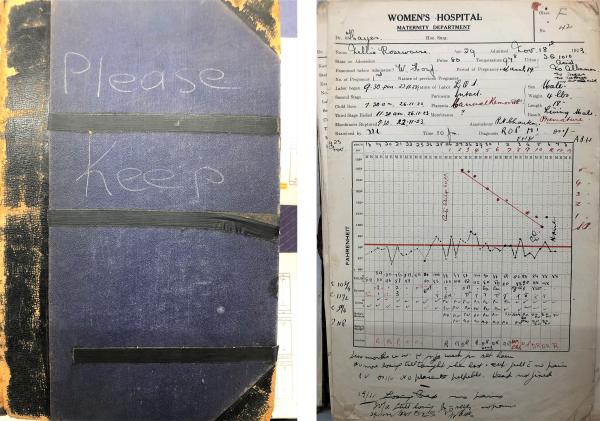
Author: Tara Oldfield
Senior Communications Advisor
Every year on the 1st of January hundreds of state archival records are made public for the first time as part of Public Record Office Victoria’s annual Section 9 openings. Under Section 9 of the Public Records Act 1973, files of a private nature are closed to prevent the violation of personal privacy. After the period set for closure ends, these files can be opened.
A broad guide to time periods for closure under Section 9 is as follows:
• Records primarily concerning adults may be closed for 75 years.
• Records concerning children as the primary subject may be closed for 99 years.
• Records such as staff records where the individuals concerned may still be in the workforce may be closed for a lesser period such as 30, 40, or 50 years as appropriate.
Learn more here.
On the 1st of January 2023, the files opened for the very first time include records related to the 1940s underworld, social worker patient histories, and the case of the Bentleigh burger murder, to name a few.
Read on for a selection of the stories to be found. The full list of newly opened files is available at the bottom of the page.
Please note the proceeding text describes records related to crime, assault and death and may be upsetting for some readers.
Underworld criminal trial brief
A criminal trial brief related to an attempted Melbourne underworld revenge killing is among the files opened on the 1st of January. George Barrett, aka John Hedley Paul, was a notorious 1940s standover man. In September 1947, he and Charles William Martin were tried for wounding with intent to commit murder of Keith Kitchener Hull.
Keith Kitchener Hull said:
“I am a wood carter and I reside at 2 Fitzroy St. St Kilda. I know the accused as Jack Paul and the accused as Charlie Martin. I have known Paul since 1944. I first met him in Sydney and I have known Charlie Martin for about 2 ½ years. On Sunday the 27th July 1947, at about 3pm Jack Paul and Charlie Martin came to a room occupied by my wife and I at 2 Fitzroy Street St Kilda. They knocked on our door and one of us called out ‘Come in.’ We had a dozen bottles of beer…Shortly after they came into the room, Charlie Martin said ‘We want a taxi, but we haven’t got enough money, will you drive us in the truck? We can get some petrol – I want to go out to Pentridge to get a chap out on bail.’ I agreed. My truck was standing outside my address in Beaconsfield Pde…Martin said ‘What are you going to do without your husband tonight, I will be back to sleep with you’. He addressed these remarks to my wife. My wife took it as a joke and I did not think anything of it at the time. About 3.20pm we left the room... I got in at the wheel of the truck, Paul got in and sat next to me, then Martin got in and sat on the outside. Martin said ‘Drive up here, and we will get some money off this fellow up here.’ He then directed me to drive up Acland Street and then turn into Robe Street, then into Neptune Lane, Martin got out and walked up to the corner of Little Neptune Lane and Neptune Street there is a post. Paul said to him ‘Have you got the opener’? They had taken three bottles of beer from our room and placed them on the back of the truck in the wood dust before we started off. I then leaned back in the seat and placed my arms on the steering wheel. I then saw Paul, who by this time, was standing on the roadway on the left hand side of the truck at the open door, with a revolver in his hand. As I turned to face the wheel, after refusing the drink, Paul said ‘cop this’ and fired; the bullet struck me in the chest on the left side. I then placed my left hand up to the spot and received another bullet in the left wrist. There was no lock on the driving side door, so I threw myself out onto the roadway and called out ‘Help.’ …I told Detectives at the hospital that I refused to say who shot me, but since then there has been attempts to shoot my wife, so I decided to tell the whole truth. I gave neither Martin nor Paul any reason for shooting me, and they did not give me any reason for shooting me. Paul was a mate of Donald Day alias Donald Duck who was shot in Sydney, and I have no doubt that this is the reason why I was shot. My wife is in the family way and I consider the tactics of these people standing over a woman is despicable, and not the same as standing over a man, and this is the reason I am giving evidence so my wife will be protected. I am not worried about myself in the matter, nor am I considering myself.” Statement taken by Detective Donelly 8/8/47.
A Detective confirmed:
“Martin had been residing at 55 Fawkner Street, St Kilda, with a prostitute named Dulcie Markham, who also has a long criminal record, and has on a number of occasions been concerned in underworld shootings. On the 31st July 1947, Dulcie Markham and Ernie Martin (Brother of Charles Martin) went to the home of Hull, seeking the whereabouts of Mrs Hull, and mentioned that they intended killing her. There were arrested for Conspiracy to murder on that charge. On the 20th of August 1947, Dulcie Markham, Graham Miles Thompson and a man named Bradshaw, intercepted Hull outside his residence and attacked him inflicting very serious injuries, and it is alleged that he was struck in the face with the butt of a gun….”
Charges against Dulcie Markham and others went nowhere, while Hull’s case against Barrett and Martin moved forward.
In the Supreme Court, Monday 15 September 1947, The King V George Barrett and Charles William Martin, Hull described his prior relationship with both Barrett and Martin. He said they knew each other from Sydney and that he and Barrett fell out after Hull shot Barrett’s mate Donald Day in self-defence. However, they ran into each other a few times in Melbourne and seemed on better terms.
Barrett on the stand agreed with Hull’s version of events up until the shooting.
In the truck “Hull said ‘You have been crook at me for years, haven’t you?’ I said ‘What makes you think that Keith?’ He said ‘You reckon I shot Duck in cold blood, don’t you?’ I said ‘Yes, that is right, I certainly do.’”
From there Barrett says he and Hull exchanged insults and it was then Hull who reached into his pocket for a gun, and said ‘Cop this.’ Barrett said he grabbed the gun off him and struggled with it. It went off once. They struggled some more and it went off again before Hull ran off leaving Barrett and Martin in the car.
“I never tried to shoot him, it was accidentally.”
Barrett and Martin were found not guilty. Read the full Criminal Trial Brief here.
Three months later in a scuffle over money, Barrett was beating on other underworld figures and threatening them when a man named Joseph Turner got hold of Barrett's gun and shot him. The inquest was held on the 19th of December. No charges were laid.
Inward registered correspondence of the law department
A fascinating collection of correspondence filed in 1947 including depositions of proceedings before the Coroner such as one for a hit and run in Warracknabeal, petty sessions fines relating to school absences, correspondence related to divorce proceedings, change of registered company names (such as Gillette pictured), forfeiture of recognisance for those criminals who have not met the terms of their release, and even applications to conduct raffles.
Social worker’s patient history books
In the first opening of this series, these books contain the patient histories of those going through the Royal Park Receiving House between 1944 and 1947. Written by the social workers of Royal Park, these histories include background on the patients’ families, schooling, work, and friendships as told to the social worker by a family member and/or patient as indicated at the top of the record.
Royal Park was opened as a Receiving House in September 1907. Receiving Houses were used to provide accommodation for those patients who required only short-term mental health diagnosis and treatment. Around the time of these records there were about 200 patients there at any one time.
These records provide an insight into the lives, not just of the patients, but of the patient’s family and friends at this period in time. Many records reveal physical health of patients in addition to mental health.
“Patient seemed quite normal until her medical advisor said he was not able yet to operate on her hernias. Then she suddenly became fearful…A sister of whom she was very fond had died a few weeks before after having a lot of trouble with a hernia and patient had been very upset about it and worried lest this should happen to her.”
The histories also include the social workers own observations about family members they meet, such as:
“Mother talked incessantly, ignoring interruptions and continually flying off on tangents. She was at great pains to prove that patient is unbalanced…”
Bentleigh burger murder capital case file
Esbert Robin Ridgway was one of four siblings. In trouble for factory breaking and stealing as a teenager he said that his early crimes were the result of being associated with other young delinquents. Since ridding himself of these bad influences, he was not in trouble with the law again until 1947.
At 12.30am on Sunday 20 April, Esbert and his brother Walter went to The Hamburger Café at 309 Centre Road in Bentleigh with two mates. They placed their order and went to sit at a table, joining 30 to 40 other diners. Next, 28-year-old builder Vincent Patrick Quinn entered with a friend. He got talking to the Ridgway brothers and a fight broke out.
Witnesses and friends of the parties disagreed about what prompted the fight. One said the argument started after Vincent saw Esbert had a knife on him, another said Vincent took issue with the brothers swearing, others said Vincent insulted Walter and Esbert defended him.
A man Trinder said:
“After Vincent Quinn was introduced to the Ridgways a fight seemed to flare up. They were arguing the point for a while. As to what they were arguing over, Vin was saying to Walter that he had a long nose.”
Quinn’s friends were knocked to the ground as staff kicked the group out the door, the fight continued outside ending up with the two Ridgway brothers on Quinn. Walter Ridgeway later told police:
“We were all pretty full. We ordered our steak and eggs, then Quinn and Jack Trinder came on about my nose. Bert stuck up for me and we got into it, and the man in the shop asked us to go outside. I dragged Quinn out of the door, and we got into it in the street again. Bert joined in and someone was trying to pull us apart. Near the end of the fight, I hit Quinn a couple of heavy blows and Bert hit him about twice.” He told police he didn’t see Bert with a knife in his hand, and went on, “I had no idea he was badly hurt. Bert came out to my sleepout and woke me up and told me that Quinn had died, but I thought he was only joking and I went to sleep again.”
When questioned by police Bert admitted:
“I first pulled out the knife to frighten them, and when I saw them coming at me, I plunged it into the first one near me, and that was Quinn.”
As to his carrying the knife, Bert told police that he had been attacked previously so wanted to carry the knife for protection. He was convicted and sentenced to 6 years hard labour. Read the full Capital Case file here.
The Chuter brothers in the central register of male prisoners
The central registers of male prisoners cover individuals held at Melbourne area prisons (Collingwood, Carlton and Williamstown stockades, the Eastern Gaol, the Hulks and Pentridge). The volume for 1947 has just been opened including pages dedicated to the Chuter brothers.
George Stanley and Stephen Patterson were born two years apart, 1922 and 1924 respectively, and looked more like twins than brothers. They were two of eight children of separated parents. It appears George began his life of crime first, but both men then went on to be in and out of trouble with the law for breaking and entering and were arrested together in Victoria in 1946 for illegal use of a motor car, shop breaking and stealing. These entries in the central register of male prisoners list both as bakers, born in NSW, and able to read and write.
Midwifery and medical student labour ward case book, and maternity department case book
From the Royal Women’s Hospital, recorded in these case books from 1958-1972 are the dates of births each student attended. The students were required to deliver 15 normal births and assist in five abnormal births, comprising one breech, three forceps and one caesarean. They also had to undertake two pelvic and one rectal examination.
On the pages below we can see caesars and breeches recorded, and dates for each time they attended a birth.
The maternity department case book is from 1923 and features deliveries including the patient’s name, age, details on the labour and the baby and other case notes as shown below.
Full list of records opened 1 January 2023
- Criminal Trial Briefs, VPRS 30, P0000, Date range opened: 1947
- Criminal Trial Briefs, VPRS 30, P0026, Date range opened: 1947
- Criminal Trial Briefs, VPRS 30, P0030, Date range opened: 1947
- Capital Case Files, VPRS 264, P0001, Date range opened: 1947
- Attorney-General’s Department Inward Registered Correspondence, VPRS 266, P0001, Date range opened: 1947
- Melbourne Divorce Case Files, VPRS 283, P0002, Date range opened: 1947
- Central Register of Male Prisoners, VPRS 515, P0000, Date range opened: 1946-1947
- Roads Corporation Secretary’s Letter Books, VPRS 527, P0000, Date range opened: 1946-1947
- Ballarat Divorce Case Files, VPRS 552, P0001, Date range opened: 1947
- Castlemaine Children’s Court Register, VPRS 736, P0000, Date range opened: 1919-1923
- Victorian Government Printing Office Record of Staff Service, VPRS 789, P0000, Date range opened: 1912-1947
- Capital Sentence Files, VPRS 1100, P0002, Date range opened: 1947
- Country Roads Board Wages Records, VPRS 1752, P0000, Date range opened: 1946-1947
- Richmond Children’s Court Register, VPRS 1792, P0000, Date range opened: Aug 1922-Nov 1923
- Pharmacy Board Minute Books, VPRS 1870, P0002, Date range opened: 1969-Jun 1972
- Criminal Trial Brief Register II, VPRS 3524, P0000, Date range opened: 1947
- Criminal Trial Brief Register II, VPRS 3524, P0001, Date range opened: 1947
- Alfred Hospital Master Patient Index Cards, VPRS 3848, P0000, Date range opened: 1945-1947
- Smythesdale Children’s Court Register, VPRS 4310, P0000, Date range opened: 1907-1923
- Ward Registers, VPRS 4527, P0001, Date range opened: Dec 1922-Oct 1923
- Divorce Cause Books, VPRS 5334, P0001, Date range opened: Nov 1946-Jul 1947
- Index to Divorce Cause Books, VPRS 5335, P0004, Date range opened: 1947
- Inpatient Admission Register, VPRS 5765, P0001, Date range opened: 1936-1947
- Mockinya Primary School Records, VPRS 6828, P0002, Date range opened: 1903-1947
- Royal Park Receiving House Head Nurses Daily Report Books, VPRS 7439, P0001, Date range opened: 1946-1947
- Kew Mental Hospital Head Attendant’s Daily Report Books Male Department, VPRS 7440, P0002, Date range opened: Apr 1946-May 1947
- Mont Park Mental Hospital Head Nurse’s Daily Report Books Female Department, VPRS 7443, P0001, Date range opened: Oct 1946-Nov 1947
- Registers of Voluntary Boarders in Hospitals for the Insane, VPRS 7515, P0001, Date range opened: 1942-1947
- Royal Park Receiving House Social Worker Histories, VPRS 7538, P0001, Date range opened: 1944-1947
- Ballarat Mental Hospital Discharge Register of Patients, VPRS 7553, P0002, Date range opened: 1933-Feb 1947
- Kew Cottages Admission Warrants, VPRS 7565, P0001, Date range opened: 1919-1923
- Kew Mental Hospital Head Nurse’s Daily Report Book Female Wards, VPRS 7692, P0001, Date range opened: Mar 1946-Apr 1947
- Sunbury Mental Hospital Nursing Report Books Female, VPRS 8252, P0001, Date range opened: Oct 1946-Nov 1947
- Sunbury Mental Hospital Admission Warrants Female, VPRS 8261, P0001, Date range opened: Jun 1945-Jun 1947
- Cheltenham Children’s Court Registers, VPRS 8714, P0001, Date range opened: Oct 1914-Mar 1923
- Main Lead Primary School Records, VPRS 9128, P0002, Date range opened: 1907-1947
- Court of Petty Sessions Index to Maintenance Cases, VPRS 9538, P0001, Date range opened: 1911-1924
- Skipton Court of Petty Sessions Maintenance Registers, VPRS 10474, P0000, Date range opened: Apr 1922-Aug 1923
- Williamstown Children’s Court Registers, VPRS 10589, P0000, Date range opened: Feb 1920-Aug 1923
- Warrnambool Children’s Court Register, VPRS 10621, P0000, Date range opened: Feb 1917-Jan 1923
- Pentridge Prison Register of Prisoners Received and Discharged J Division, VPRS 10874, P0002, Date range opened: 1947
- Tramway Employee Record Cards, VPRS 12739, P0001, Date range opened: 1966-1967
- Victorian Railways Correspondence with Australian Railway Union regarding industrial issues, Transportation Division, VPRS 13279, P0001, Date range opened: 1966-1967
- Victorian Railways Accident Compensation Claim Register, VPRS 13531, P0001, Date range opened: 1966-1967
- Victorian Railways Accident Compensation Claim Register, VPRS 13531, P0003, Date range opened: 1963-1967
- Swinburne Technical College Examination Results, VPRS 14019, P0001, Date range opened: 1947-1948
- Country Roads Board Minutes, VPRS 14351, P0001, Date range opened: 1972
- Victorian Nursing Council Executive Committee Minutes, VPRS 16379, P0001, Date range opened: Feb 1971-1972
- Medical Board of Victoria Board Minutes, VPRS 16389, P0002, Date range opened: 1966-Apr 1972
- Chiropodists Registration Board of Victoria Minutes, VPRS 16482, P0001, Date range opened: 1970-1972
- Dental Board of Victoria School Dental Therapists Register, VPRS 16522, P0001, Date range opened: 1975-1992
- Court of General Sessions Criminal Presentments and Final Orders, VPRS 17020, P0003, Date range opened: Jan-Oct 1947
- Royal Women’s Hospital Birth Registers Midwifery Department, VPRS 17383, P0002, Date range opened: Jun 1918-Aug 1923
- Royal Women’s Hospital Case Book Maternity Department, VPRS 17387, P0001, Date range opened: 1923
- Royal Women’s Hospital Midwifery and Medical Student Labour Ward Case and Statistics Books, VPRS 17587, P0002, Date range opened: 1958-1972
- Fairfield Infectious Diseases Hospital Admission and Discharge Register of Patients, VPRS 17792, P0002, Date range opened: Feb 1922-Apr 1923
- Beechworth Mental Hospital Observation Ward Report Books Male, VPRS 18101, P0002, Date range opened: Jun 1946-Jul 1947
- Box Hill Children’s Court Register, VPRS 18144, P0001, Date range opened: Apr 1916-Jan 1923
- Ferntree Gull Children’s Court Register, VPRS 18147, P0001, Date range opened: Jul 1908-Jan 1923
Material in the Public Record Office Victoria archival collection contains words and descriptions that reflect attitudes and government policies at different times which may be insensitive and upsetting
Aboriginal and Torres Strait Islander Peoples should be aware the collection and website may contain images, voices and names of deceased persons.
PROV provides advice to researchers wishing to access, publish or re-use records about Aboriginal Peoples
